Cozy Catastrophes and Sinister Archaeology: Weird Tales #364 edited by Jonathan Maberry
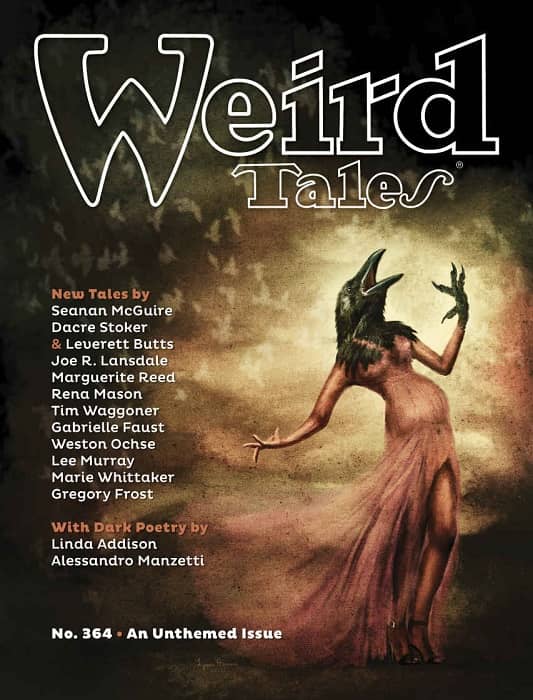 |
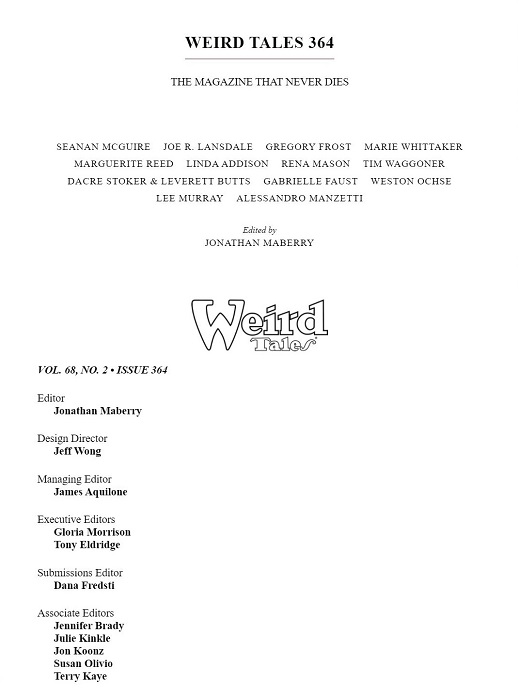 |
Weird Tales #364. Cover by Lynne Hansen
As I write this, Weird Tales falls just two years short of celebrating its centennial — an astonishing feat, given that the fiction magazines in existence at that time, all considered far more prestigious than this lurid showcase of fantasy and horror, have vanished into time and space as if they never existed. (Only Argosy, revived in 2016 by Altus Press, matches it in longevity.) With such august placement in pop culture history, and given the differing tastes of its various editors (from Lin Carter to Ann VanderMeer), one might wonder if recent editions maintain the seminal publication’s pulp sensibilities while meeting exacting modern standards.
Under Jonathan Maberry’s editorial eye, that answer appears to be a resounding yes. With seven stories, four pieces of flash fiction, and two poems, Weird Tales #364 improves on its previous issue in the professionalism and sense of vision each writer brings as well as the sense of history infusing each work. As Maberry says in the introductory piece The Eyrie, “What delights me most as editor is that these stories are so diverse in terms of content, theme, styles, and genre. They don’t belong anywhere else — they are true Weird Tales.”
The magazine opens with Seanan McGuire’s “Too Late Now,” a Wyndham-esque “cozy catastrophe” lacking the coziness Wyndham brings to such works as The Day of the Triffids and The Chrysalids. Alien vegetation has overtaken life on earth, leaving humans to scavenge for non-organic goods (the plant life grows on almost any formerly organic matter) in order to maintain some semblance of society. Boston (people have begun naming themselves after cities and states in an effort to maintain continuity with the pre-Invasion world) is forced to take a team to the place where she lost her partner Jersey. McGuire mixes the worldbuilding she brings to such works as Every Heart a Doorway and Middlegame with adept pacing and suspense.
Shifting into more traditional Lovecraftian territory, “Ellende” by Gregory Frost tells the tale of a married couple driving to a lakeside vacation in the postwar American South. They stop in a town for gas, encounter a carnival, and then things become even stranger. If the tale feels familiar, Frost still makes it chilling, evoking place without resorting to obvious references. He also captures the gender dynamics of the period, saying much with only a few lines of dialogue and pointed observation. It’s fully modern yet would have felt right at home in its period.
From the fully modern to the ultramodern, Marie Whittaker’s “The Legend of Lightning Lizzie,” the magazine’s first piece of flash fiction, gives readers a glimpse of the banality and terror of small-town legends, which a group of teenagers recount as a lightning storm approaches. A brief, entertaining, and nasty shocker (pun intended).
Marguerite Reed’s “The Beguiled Grave” is this issue’s first true quill fantasy. In a land where witchcraft is outlawed, the mercenary Varka consults with the dead and fights with guards as she attempts to rescue a political prisoner from a dungeon. With nods to Joanna Russ’s Alyx and Fritz Leiber’s Lankhmar tales, Reed weaves a tale filled with intrigue and deception with the same keen cloth she brought to her outstanding novel Archangel. A strong work, and a world one might be pleased to revisit.
Serving as a coda to the preceding tales is Linda D. Addison’s poem “The Last War.” Flavored by Allessandro Manzetti’s ‘The Canal,’” it tells of nature reasserting itself in those places where human beings have fought and died. Lyrical and haunting, Addison’s brief piece lingers after the final stanza.
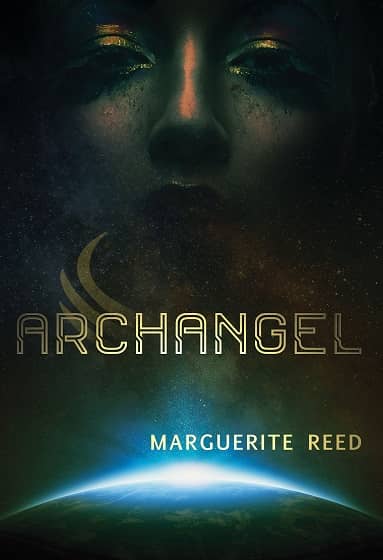 |
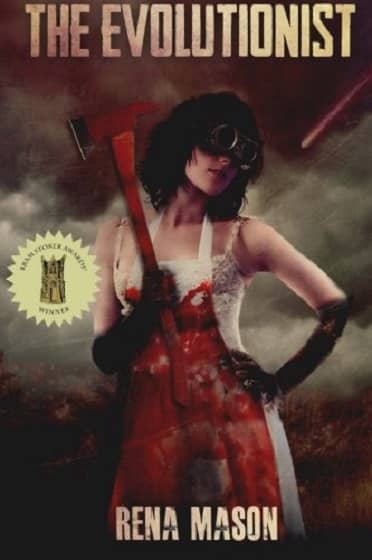 |
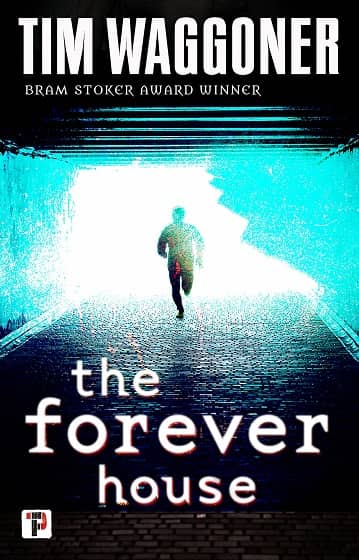 |
Archangel by Marguerite Reed (Arche Press, 2015), The Evolutionist by Rena Mason (Nightscape, 2013), and
The Forever House by Tim Waggoner (Flame Tree Press, 2020). Covers: unknown, George Cotronis, unknown
Haunting also describes Rena Mason’s “To the Marrow,” in which a pair of archaeologists, previously engaged, finds sinister spirals etched at an archaeological site in Queensland, Australia. Told in a semi-epistolary form (specifically smart phone recordings and news stories as well as third-person narrative), Mason melds her interest in anthropology and cosmology in this horrific piece (as she did with her incredible novel The Evolutionist), a seamless melding of James Rollins and the writing team Douglas Preston and Lincoln Child. You won’t hear a B-flat note in the same way again.
And you won’t look at feathers the same way after reading Tim Waggoner’s flash piece “Feathers,” in which a therapist’s patient tells of his fear of feathers, causing his madness to bleed into the therapist. It’s as hallucinatory and nightmarish a piece as one would expect from the author of The Forever House.
“Last Days” by Dacre Stoker and Leverett Butts looks past the Weird Tales period to the work of Stoker’s great-grand uncle Bram Stoker. Revisiting the world of Dracul, the prequel to Dracula, Stoker and Butts offer a series of diary entries, telegraphs, and travel journals as R. M. Renfield travels to Munich before succumbing to the vampire Herr Walters. The writing team brings to life Europe at the end of the Nineteenth Century and creates chilling scenes (as when Renfield spies Walters in an opera house) with economy, though the story is over much too soon.
Chilling, too, is Gabrielle Faust’s “Trailer Park Nightmare,” in which a young woman wakes from a nightmare that follows her into consciousness. Shocking and uncomfortable in the best ways, it’s a prose poem suffused with disturbing imagery.
Longer but no less prosaic is Weston Ochse’s “No One Ever Survives the Beach,” the most fully Weird tale of the issue. A fantastic piece of allegory, it recounts a battle between armed forces as they attempt to land on enemy territory. It is a story of warfare stitching together the sensibilities of Jack Vance and China Mieville, adding elements of Clive Barker for good measure. It’s the strangest piece in this issue, and serves as a phantasmagoric companion to Marguerite Reed’s “The Beguiled Grave.”
In “Hats,” Joe R. Lansdale channels Charles Beaumont and Richard Matheson as his story follows a man into a hat store that shows wearers a life outside of their mundane world. A fun fantasy, with Lansdale’s adept humor underlying every sentence.
The final tale is Lee Murray’s “The Good Wife,” about a woman who must rescue her husband from a dragon’s captivity, first by bringing it food, and then by taking the husband’s place. Murray builds her story with elements of fairy tale and folklore, setting it in an Asia reminiscent of Barry Hughart’s Bridge of Birds. A powerful tale of love and betrayal.
Closing this issue is Alessandro Manzetti’s poem “The Canal.” Inspired by Lovecraft’s “The Canal,” this lyrial piece describing a place in India where headless human beings are separated by a canal of oily black water. Manzetti crafts a dizzying landscape of macabre imagery, a travelogue of fantasy and terror.
In its nearly one-hundred-year history, Weird Tales has provided us with incredible work by talented writers and poets. If this issue is anything to go by, it still serves us well.
Weird Tales is edited by Jonathan Maberry and published by Weird Tales, Inc. This issue is 165 pages (digital). Copies are $12.99 for the print edition and $9.99 for the digital version; order directly at the website here.
Derek Austin Johnson has lived most of his life in the Lone Star State. His work has appeared in The Horror Zine, Rayguns Over Texas!, Horror U.S.A.: Texas, Terror Tract, and Campfire Macabre.
He lives in Central Texas.